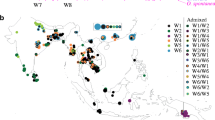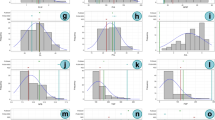Abstract
The cross compatible wild relatives of crops have furnished valuable genes for crop improvement. Understanding the genetics of these wild species may enhance their further use in breeding. In this study, sequence variation of the nuclear Lhs1 gene was used to investigate the population genetic structure and gene flow of Oryza rufipogon and O. nivara, two wild species most closely related to O. sativa. The two species diverge markedly in life history and mating system, with O. rufipogon being perennial and outcrossing and O. nivara being annual and predominantly inbreeding. Based on sequence data from 105 plants representing 11 wild populations covering the entire geographic range of these wild species, we detected significantly higher nucleotide variation in O. rufipogon than in O. nivara at both the population and species levels. At the population level the diversity in O. rufipogon (Hd = 0.712; θ sil = 0.0017) is 2–3 folds higher than that in O. nivara (Hd = 0.306; θ sil = 0.0005). AMOVA partitioning indicated that genetic differentiation among O. nivara populations (78.2%) was much higher than that among O. rufipogon populations (52.3%). The different level of genetic diversity and contrasting population genetic structure between O. rufipogon and O. nivara might be explained by their distinct life histories and mating systems. Our simulation using IM models demonstrated significant gene flow from O. nivara to O. rufipogon, indicating a directional introgression from the annual and selfing species into the perennial and outcrossing species. The ongoing introgression has played an important role in shaping current patterns of genetic diversity of these two wild species.


Similar content being viewed by others
References
Barbier P, Morishima H, Ishihama A (1991) Phylogenetic relationships of annual and perennial wild rice: probing by direct DNA sequencing. Theor Appl Genet 81:693–702
Baudry E, Kerdelhue C, Innan H, Stephan W (2001) Species and recombination effects on DNA variability in the tomato genus. Genetics 158:1725–1735
Cai H-W, Wang X-K, Morishima H (2004) Comparison of population genetic structures of common wild rice (Oryza rufipogon Griff.), as revealed by analyses of quantitative traits, allozymes, and RFLPs. Heredity 92:409–417
Charlesworth D (2003) Effects of inbreeding on the genetic diversity of populations. Phil Trans R Soc Lond B Biol Sci 358:1051–1070
Cheng C, Motohashi R, Tsuchimoto S, Fukuta Y, Ohtsubo H, Ohstubo E (2003) Polyphyletic origin of cultivated rice: based on the interspersion pattern of SINEs. Mol Biol Evol 20:67–75
Chiang Y-C, Schaal BA, Chou C-H, Huang S, Chiang T-Y (2003) Contrasting selection modes at the Adh1 locus in outcrossing Miscanthus sinensis vs. inbreeding Miscanthus condensatus (Poaceae). Am J Bot 90:561–570
Excoffier L, Laval G, Schneider S (2005) Arlequin ver. 3.0: an integrated software package for population genetics data analysis. Evol Bioinform Online 1:47–50
Eyre-Walker A, Gaut RL, Hilton H, Feldman DL, Gaut BS (1998) Investigation of the bottleneck leading to the domestication of maize. Proc Natl Acad Sci USA 95:4441–4446
Fu Y-X, Li W-H (1993) Statistical tests of neutrality of mutations. Genetics 133:693–709
Gao L, Ge S, Hong D-Y (2000) Allozyme variation and population genetic structure of common wild rice, Oryza rufipogon Griff. in China. Theor Appl Genet 101:494–502
Ge S, Oliveira GCX, Schaal BA, Gao L-Z, Hong D-Y (1999) RAPD variation within and between natural populations of the wild rice Oryza rufipogon from China and Brazil. Heredity 82:638–644
Glemin S, Bazin E, Charlesworth D (2006) Impact of mating systems on patterns of sequence polymorphism in flowering plants. Proc R Soc Biol Sci 273:3011–3019
Gonzalez-Rodriguez A, Bain JF, Golden JL, Oyama K (2004) Chloroplast DNA variation in the Quercus affinis-Q. laurina complex in Mexico: geographical structure and associations with nuclear and morphological variation. Mol Ecol 13:3467–3476
Hamrick JL, Godt MJW (1990) Allozyme diversity in plant species. In: Brown AHD, Clegg MT, Kahler AL, Weir BS (eds) Plant Population Genetics, Breeding and Genetic Resources. Sinauer Associates Inc., Sunderland, pp 43–63
Hey J (2006) Recent advances in assessing gene flow between diverging populations and species. Curr Opin Genet Dev 16:592–596
Hey J, Nielsen R (2004) Multilocus methods for estimating population sizes, migration rates and divergence time, with applications to the divergence of Drosophila pseudoobscura and D. persimilis. Genetics 167:747–760
Hilton H, Kliman RM, Hey J (1994) Using hitchhiking genes to study adaptation and divergence during speciation within the Drosophila melanogaster species complex. Evolution 48:1900–1913
Hudson RR, Kaplan NL (1985) Statistical properties of the number of recombination events in the history of a sample of DNA sequences. Genetics 111:147–164
Jeon J-S, Jang S, Lee S, Nam J, Kim C, Lee S-H, Chung Y-Y, Kim S-R, Lee YH, Cho Y-G, An G (2000) leafy hull sterile1 is a homeotic mutation in a rice MADS box gene affecting rice flower development. Plant Cell 12:871–884
Khush GS (1997) Origin, dispersal, cultivation and variation of rice. Plant Mol Biol 35:25–34
Kuroda Y, Sato Y-I, Bounphanousay C, Kono Y, Tanaka K (2007) Genetic structure of three Oryza AA genome species (O. rufipogon, O. nivara and O. sativa) as assessed by SSR analysis on the Vientiane Plain of Laos. Conserv Genet 8:149–158
Liu F, Zhang L, Charlesworth D (1998) Genetic diversity in Leavenworthia populations with different inbreeding levels. Proc Biol Sci 265:293–301
Londo JP, Chiang Y-C, Hung K-H, Chiang T-Y, Schaal BA (2006) Phylogeography of Asian wild rice, Oryza rufipogon, reveals multiple independent domestications of cultivated rice, Oryza sativa. Proc Natl Acad Sci USA 103(25):9578–9583
Lu B-R, Naredo MEB, Juliano AB, Jackson MT (2000) Preliminary studies on taxonomy and biosystematics of the AA genome Oryza species (Poaceae). In: Jacobs SWL, Everett J (eds) Grasses: systematics and evolution. CSIRO, Melbourne, pp 51–58
Lu B-R, Zheng KL, Qian HR, Zhuang JY (2002) Genetic differentiation of wild relatives of rice as assessed by RFLP analysis. Theor Appl Genet 106:101–106
Morishima H, Barbier P (1990) Mating system and genetic structure of natural populations in wild rice Oryza rufipogon. Plant Species Biol 5:31–39
Morishima H, Sano Y, Oka HI (1984) Differentiation of perennial and annual types due to habitat conditions in the wild rice Oryza perennis. Plant Syst Evol 144:119–135
Nei M (1987) Molecular evolutionary genetics. Columbia Universtiy Press, New York
Oka HI (1988) Origin of cultivated rice. Japan Scientific Societies Press, Tokyo
Pons O, Petit RJ (1996) Measuring and testing genetic differentiation with ordered versus unordered alleles. Genetics 144:1237–1245
Rakshit S, Rakshit A, Matsumura H, Takahashi Y, Hasegawa Y, Ito A, Ishii T, Miyashita NT, Terauchi R (2007) Large-scale DNA polymorphism study of Oryza sativa and O. rufipogon reveals the origin and divergence of Asian rice. Theor Appl Genet 114:731–743
Rozas J, Sanchez-DelBarrio JC, Messeguer X, Rozas R (2003) DnaSP, DNA polymorphism analyses by the coalescent and other methods. Bioinformatics 19:2496–2497
Sang T, Ge S (2007) Genetics and phylogenetics of rice domestication. Curr Opin Genet Dev 17:533–538
Schaal BA, Hayworth DA, Olsen KM, Rauscher JT, Smith WA (1998) Phylogeographic studies in plants: problems and prospects. Mol Ecol 7:465–474
Second G (1985) Evolutionary relationships in the sativa group of Oryza based on isozyme data. Genet Sel Evol 17:89–114
Slatkin M (1993) Isolation by distance in equilibrium and non-equilibrium populations. Evolution 47:264–279
Song Z-P, Zhu W-Y, Rong J, Xu X, Chen J-K, Lu B-R (2006) Evidences of introgression from cultivated rice to Oryza rufipogon (Poaceae) populations based on SSR fingerprinting: implications for wild rice differentiation and conservation. Theor Appl Genet 114:731–743
Sun CQ, Wang XK, Li ZC, Yoshimura A, Iwata N (2001) Comparison of the genetic diversity of common wild rice (Oryza rufipogon Griff.) and cultivated rice (O. sativa L.) using RFLP markers. Theor Appl Genet 102:157–162
Sweigart AL, Willis JH (2003) Patterns of nucleotide diversity in two species of Mimulus are affected by mating system and asymmetric introgression. Evolution 57:2490–2506
Tajima F (1989) Statistical method for testing the neutral mutation hypothesis by DNA polymorphism. Genetics 123:585–595
Thompson JD, Gibson TJ, Plewniak F, Jeanmougin F, Higgins DG (1997) The Clustal X windows interface: flexible strategies for multiple sequence alignment aided by quality analysis tools. Nucleic Acids Res 25:4876–4882
Vaughan DA (1989) The genus Oryza L.: current status of taxonomy. International Rice Research Institute, Manila
Vaughan DA, Morishima H (2003) Biosystematics of the genus Oryza. In: Smith CW, Dilday RH (eds) Rice: origin, history, technology, and production. Wiley, London, pp 27–65
Vaughan D, Morishima H, Kadowaki K (2003) Diversity in the Oryza genus. Curr Opin Plant Biol 6:139–146
Watterson GA (1975) On the number of segregating sites in genetical models without recombination. Theor Popul Biol 7:256–276
Won Y-J, Sivasundar A, Wang Y, Hey J (2005) On the origin of Lake Malawi cichlid species: a population genetic analysis of divergence. Proc Natl Acad Sci USA 102:6581–6586
Wright SI, Gaut BS (2005) Molecular population genetics and the search for adaptive evolution in plants. Mol Biol Evol 22:506–519
Yoshida K, Miyashita N (2005) Nucleotide polymorphism in the Adh2 region of the wild rice Oryza rufipogon. Theor Appl Genet 111:1215–1228
Yoshida K, Miyashita NT, Ishii T (2004) Nucleotide polymorphism in the Adh1 locus region of the wild rice Oryza rufipogon. Theor Appl Genet 109:1406–1416
Zhou H-F, Xie Z-W, Ge S (2003) Microsatellite analysis of genetic diversity and population genetic structure of a wild rice (Oryza rufipogon Griff.) in China. Theor Appl Genet 107:332–339
Zhu Q, Ge S (2005) Phylogenetic relationships among A-genome species of the genus Oryza revealed by intron sequences of four nuclear genes. New Phytol 167:249–265
Zhu Q, Zheng X, Luo J, Gaut BS, Ge S (2007) Multilocus analysis of nucleotide variation of Oryza sativa and its wild relatives: severe bottleneck during domestication of rice. Mol Biol Evol 24:875–888
Acknowledgments
We thank Dr. Akito Kaga, National Institute of Agrobiological Sciences of Japan, for his technological assistance in sequencing. Hai-Fei Zhou thanks JIRCAS of Japan for supporting his stay in National Institute of Agrobiological Sciences of Japan. This study was supported by the National Basic Research Program of China (2007CB815704) and National Natural Science Foundation of China (30430030, 30121003) and JIRCAS of Japan.
Author information
Authors and Affiliations
Corresponding author
Additional information
Communicated by T. Sasaki.
Rights and permissions
About this article
Cite this article
Zhou, HF., Zheng, XM., Wei, RX. et al. Contrasting population genetic structure and gene flow between Oryza rufipogon and Oryza nivara . Theor Appl Genet 117, 1181–1189 (2008). https://doi.org/10.1007/s00122-008-0855-7
Received:
Accepted:
Published:
Issue Date:
DOI: https://doi.org/10.1007/s00122-008-0855-7




